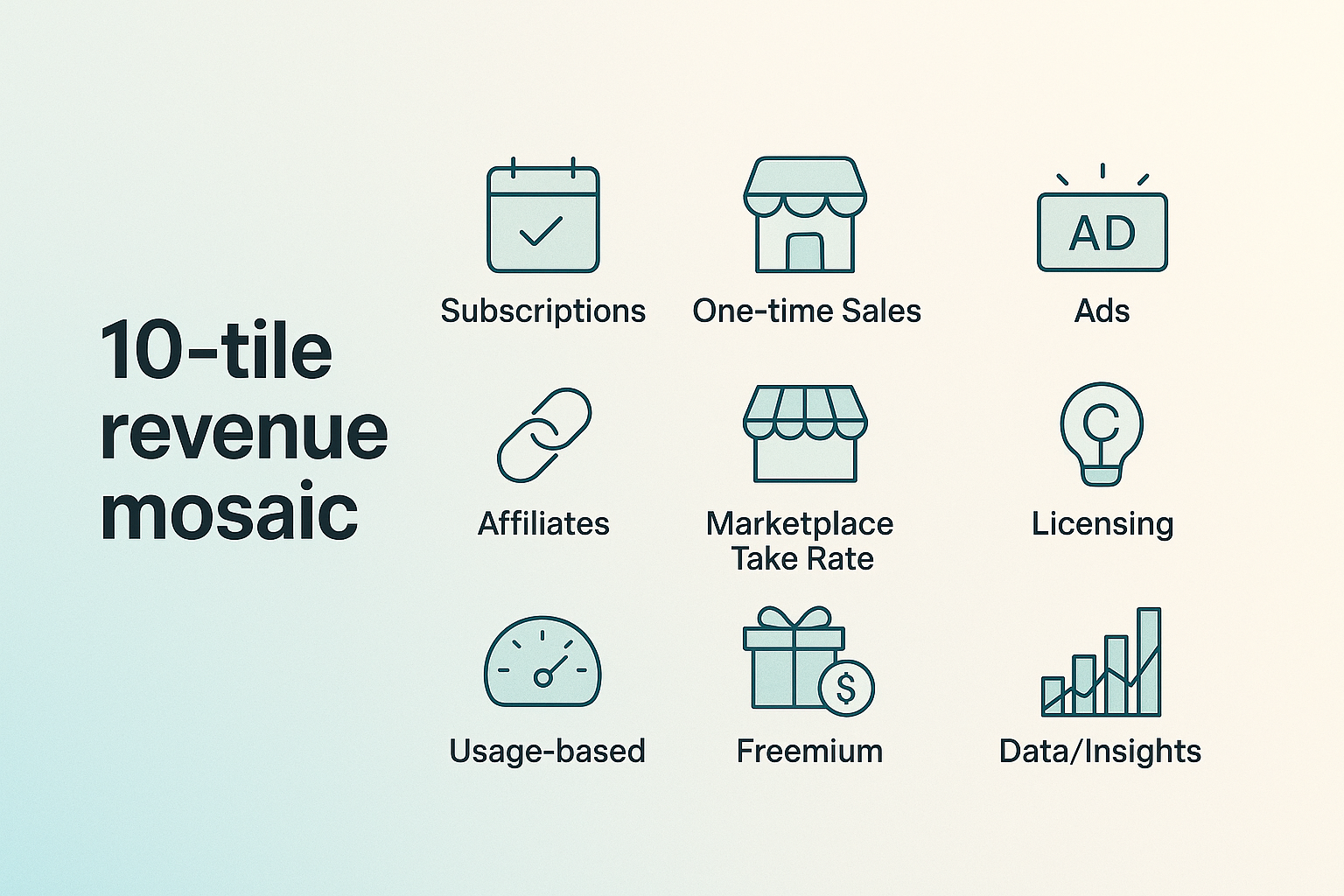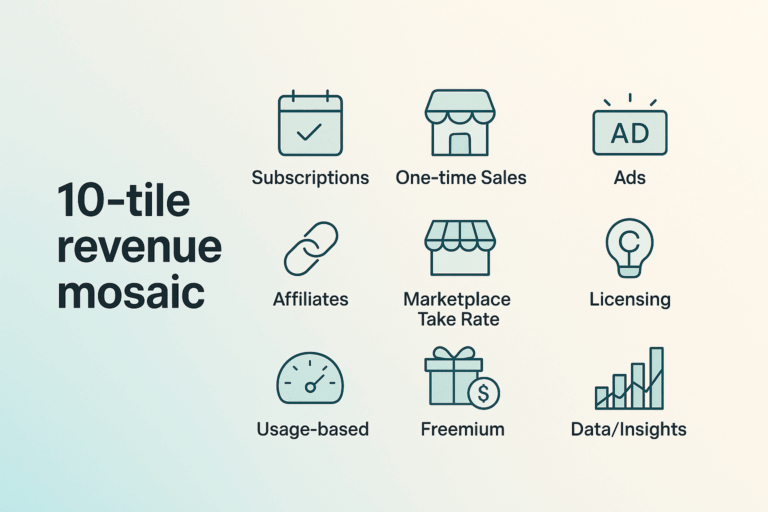Revenue Models Explained: 10 Proven Ways to Make Money
Every successful business has one key component: a clear path to revenue. Yet 90% of startups fail in their first year because they confused having a great product with having a viable revenue model.
You may have the most innovative solution in your market but without a sustainable way to capture value from your customers you’re building a hobby not a business. The difference between thriving companies and failed ventures often comes down to one key decision made early in the journey: choosing the right revenue model.
The business landscape has changed dramatically. Traditional one time sales models now compete with sophisticated subscription services, freemium strategies, and hybrid approaches that would have been impossible a decade ago. Understanding these options, and more importantly knowing how to choose between them, can mean the difference between your startup being in the 10% that survive or becoming another cautionary tale.
This guide breaks down the 10 most proven revenue models of today’s successful businesses, provides a framework for choosing the right one for your venture and shares battle tested strategies for implementation. You’ll learn exactly how companies make their money and how to build your own sustainable path to profitability.
What is a Revenue Model? Revenue Model Definition and Its Importance
A revenue model is the way your business converts value into income. You can think of it as the engine that turns your product or service into the actual money that will go into your bank account. While your business model describes the big picture of what you do and for whom, your revenue model specifically answers the question: “How do we get paid?”
Consider Spotify’s approach. Their business model is licensing music and delivering it through a streaming platform. Their revenue model? A combination of free ad supported streaming and premium subscriptions. This matters because you could deliver the same service through entirely different revenue mechanisms, imagine if Spotify charged per song played or sold lifetime memberships instead.
Revenue Model vs Business Model vs Pricing Strategy
These three concepts are related and work together but they each serve a different purpose. Your business model is the big picture of how you create value for the customer and all of your business interactions. It’s how you create, deliver, and capture value. Your revenue model is one part of this. It focuses on the money making mechanism. Your pricing strategy drills down even further to determine the specific amounts you’ll charge. Here’s a practical example: Amazon’s retail arm has a business model of online marketplace and logistics. Amazon’s revenue model is primarily transactional (direct sales). But, they do incorporate other models as well. Now, their pricing strategy is dynamic pricing and it is based on the competition, the generated demand, and the inventory levels at that snapshot in time. Each of these three considerations is essentially a layer that builds on the previous one. But, people in business mix these concepts up all of the time and that creates strategic confusion.
The Cost of Getting It Wrong: Statistics and Case Studies
Companies with clear revenue models are 2.5x more likely to achieve profitability within three years according to Startup Genome’s research. The wrong choice however can be catastrophic. MoviePass famously burned through $300 million by offering unlimited movie tickets for $9.95 a month. This was a subscription model that was misaligned with their cost structure.
Compare this to ClassPass which initially made the same mistake with unlimited fitness classes. But, ClassPass identified this problem early on and they pivoted to a credit based system. The difference here is that ClassPass recognized the early warning signs and responded. They adjusted their revenue model before the could deplete their resources, aka go bankrupt. Your choice of revenue model isn’t just about making money. This is a strategic decision and it’s about sustainable unit economics that your business can scale with growth.
Key Takeaway: Your revenue model must align with both your cost structure and customer expectations. You should test your assumptions early and be prepared to pivot if the math isn’t working.
A $7.5 Trillion Opportunity: Revenue Model Innovation in 2025
Market Size by Revenue Model Type
The global shift towards recurring revenue has created unprecedented opportunities in 2025. The subscription economy grew 435% over the past decade. It was worth $650 billion in 2024. But these subscriptions are just one slice of the whole pie. Marketplace models now make up over $3.8 trillion in gross merchandise value annually. All this while digital advertising generates an additional $600 billion globally.
What is driving this explosion? It’s the digital transformation, and the fact that it has lowered the barriers to implementing sophisticated revenue models in all types of businesses, from big to small. You no longer need Amazon’s infrastructure to run a marketplace or Netflix’s technology to launch a subscription service. Modern payment processors, subscription management platforms and no-code tools have democratized access to these revenue models that at one time required millions in upfront investment.
The Fastest-Growing Revenue Models Post-Pandemic
The pandemic started and it accelerated what was already happening. It sped up these existing trends and also ended up creating entirely new categories. Usage-based pricing grew 38% year-over-year, since the Pandemic, as businesses have sought more flexible cost structures. Now, many businesses incorporate hybrid models, such as combining physical products with digital subscriptions. This alone saw a 45% growth a rate, and was exemplified by Peloton’s meteoric rise and also, Mirror’s $500 million acquisition by Lululemon. Creator economy platforms have further created new commission-based models. Here, with Substack, OnlyFans and Patreon collectively processing over $10 billion in creator earnings. These platforms have proven that innovative revenue models can create entirely new markets not just capture an existing demand.
Industry-Specific Opportunities Were Created
Different industries have favored different models based on their specific dynamics. Business-to-business (B2B) Software-as-a-serviece (SaaS) has almost universally adopted subscription models. In 2025, 72% of businesses are now planning to offer subscription services by the end of the year. Healthcare is also adopting membership models for primary care while education platforms can blend together two models: one-time course sales and also with subscription-based cohort programs.
What is the key insight here? It could be the case that your industry’s traditional revenue model might be ripe for disruption. The Dollar Shave Club didn’t invent razors. But, they applied a subscription model to a transactional market and the company sold for $1 billion. You should likely look for similar opportunities where your customer behavior has evolved faster than your business models might have evolved.
Key Takeaway: The best revenue model opportunities can often exist at the intersection of traditional industries and modern technologies, like payment technologies. Do not limit yourself. Look beyond what’s always been done in your sector. A common saying among employees, “We’ve always done it this way.”
10 Revenue Models That Entrepreneurs Should Consider
1. Subscription Model
The subscription model charges customers a recurring fee for access to a product or a service. Customers will pay predictable amounts in equal time periods, for example, monthly, quarterly or annually. Under the subscription model, customers will pay for delivery of an ongoing value. This model will create recurring revenue streams that are predictable and will likely compound over time.
Best for: SaaS companies, content platforms, membership sites, and any business with ongoing customer relationships.
Example: Netflix is the subscription model king. They have about 247 million global subscribers that generate $33 billion annually for the company. Their success stems from continuously adding value through streaming new content, custom personalization, and an effort on global expansion. These factors help to justify their recurring charges.
Potential drawback: There are high customer acquisition costs. These can take many months to recoup requiring a significant amount of upfront capital.
2. Transactional or Direct Sales
The transactional or direct sales model involves customers making a one-time purchase where the customers buy products or services ongoing, directly as they need them. Revenue in this model will directly correlates with the sales volume. This process makes this model really straightforward to understand. It is intuitive but it is also potentially volatile because each transaction will stand alone without any guarantee of any future purchases.
Best for: E-commerce, retail, professional services, and businesses that might have infrequent purchase cycles.
Example: Amazon’s retail operation processes over $500 billion in annual transactions. This proves this model’s scalability. Amazon’s success comes from reducing friction in the purchase process while leveraging data to drive repeat purchases even though there is no subscription lock-in with this model.
Potential drawback: There is constant pressure to acquire new customers or to somehow find ways to drive repeat purchases without any future guaranteed revenue.
3. Freemium
Freemium offers a basic free version while offering to charge for premium features or capacity. The freemium model uses free products offered to users to drive adoption of the product or service. Then, the model seeks to somehow convert a percentage of those free users into some kind of paid plan. The free tier here acts as both a marketing tool and product market validation.
Best for: Software companies, productivity tools, and digital services that have already have low marginal costs.
Example: Dropbox grew to 700 million users with the freemium model. They offered free storage space to users. Later, they then converted about 3% of these free users into their paid plans. They generated $2.5 billion annually. They succeeded by making the free version genuinely useful while also creating multiple, natural upgrades that triggered through storage limitations.
Potential drawback: Supporting millions of free users can be a very expensive proposition and the conversion rates off of such a model are typically in single digits as a percentage of total customers.
4. Marketplace or Commission
Marketplace models connect buyers and sellers. The marketplace takes a commission, a percentage of each transaction. Companies can facilitate these exchanges without holding any inventory or providing any direct services. The revenue in this model scales with transaction volume across the marketplace platform.
Best for: Platforms connecting fragmented supply and demand, service marketplaces, and business-to-business (B2B) procurement.
Example: Airbnb earns a 15% average commission on its $85 billion in gross bookings. This generates nearly $13 billion annually for the company. Their success comes from solving the trust problem and the payment problems that prevented peer-to-peer lodging from scaling prior to this.
Potential drawback: This is the classic chicken-and-the-egg problem. The company needs to have sellers to attract the buyers and needs to have the buyers in order to attract the sellers. Vice versa.
5. Advertising Model
The advertising model provides free products or services to users all while selling their users attention to paying advertisers. This revenue comes from displaying ads. Payment is typically based on impressions, clicks, or conversions. User data can enable advertisers to targeted their advertising. This can command premium rates.
Best for: Content platforms, social networks, and services with massive user bases.
Example: Google generates over $230 billion annually from advertising. It generates most of the company’s revenue primarily through advertising on its search and YouTube platforms or websites. Google’s success comes from an unmatched user intent data and a very sophisticated auction system. This is a system that allows for maximizing revenue per query.
Potential drawback: It requires massive scale to generate significant revenue from this kind of advertising and user experience can suffer if there are excessive and/or annoying ads.
6. Licensing Model
Licensing grants others the right to use your intellectual property in exchange for fees or royalties paid to you. The revenue comes from allowing others to leverage your innovations, your brand and/or content. This is a model that scales without any direct fulfillment costs.
Best for: Software companies, content creators, patent holders, and very strong brands.
Example: Microsoft’s licensing of Windows and their Office products to its enterprise Windows customers generates over $80 billion annually. They have succeeded by making their software indispensable to normal business operations of a majority of companies. This creates great switching costs that almost consistently ensures the renewal of payments.
Potential drawback: This revenue model requires valuable intellectual property and a solid legal infrastructure to protect and enforce Microsoft’s rights as a company.
7. Affiliate Model
The affiliate model, it earns commissions for a company from other businesses by referring its customers to those businesses. The company promotes the products or services of another company and then the promoting company receives a percentage of any sales that do result. The revenue depends on the company’s ability to drive qualified traffic that will also convert.
Best for: Content creators, review sites, influencers, and businesses that have engaged audiences.
Example: The Wirecutter was acquired by the New York Times for $30 million. This company built a business entirely by using affiliate commissions. They leveraged their trusted product recommendations to its customers. Their success came from having genuine expertise and and also maintaining reader trust above just seeking commission rates.
Potential drawback: There is a dependence here in this revenue model on the third-party programs and the commission structures that you don’t have any control over.
8. Usage-Based or Pay-as-You-Go
Usage-based pricing charges customers based on their actual consumption of a company’s service. The prices should typically scale directly with the perceived value received. This method more closely aligns customer costs with their usage patterns. The model offers the ultimate flexibility for customers that might have variable needs.
Best for: Infrastructure services, APIs, cloud computing, and businesses with measurable consumption metrics.
Example: AWS pioneered cloud computing’s pay-as-you-go model. This revenue model generates Amazon $90 billion annually from their cloud computing. Their success comes from the fully documented, granular pricing that lets startups begin small and then seamlessly scale their projects to enterprise levels.
Potential drawback: Revenue might be more unpredictable and revenue may be more complex to project in forecasting and billing.
9. Razor and Blade Model
This model sells a primary product at a low margin, or even a loss (called a loss leader), while it generates profit from the promotion and repeat purchasing behavior of its consumable products. Here, the initial purchase creates a hopeful lock-in for the company in ongoing future consumable sales. The revenue model generates revenue primarily from the recurring consumable purchase payments of its ongoing customers.
Best for: Products with consumable components, hardware that sells with software services, and businesses that can seek some sort of customer lock-in behavior.
Example: HP sells printers at near cost but the company generates billions from the sales of its printer ink cartridges. These margins exceed 60%. That’s significant. Their success comes from making original cartridges that are technically superior while also creating increased switching costs and friction because their product offerings are through their own proprietary designs.
Potential drawback: This revenue model requires capital to subsidize the initial product sales and it also faces constant threats from generic alternatives.
10. Data Monetization Model
By collecting, analyzing and selling insights from user data in their data, data monetization can make real money. Here, sales of analytics, aggregated data and/or targeted access to specific user segments generate revenue. This model often works as a secondary revenue stream alongside another model that is the primary revenue stream,.
Ideal for: Internet of Things (IoT) companies, platforms with large user bases and companies gathering important behavioral data.
Example: One powerful example here is Credit Karma. The company offers free credit scores to users but they make $1.5 billion annually. They do this by using their collected user data to suggest financial products directly to its users. Using their revenue model, they have succeeded by providing real value to users while also matching users with the right financial products.
Potential drawback: Increasing privacy regulations could impact this revenue model and consumer awareness might create compliance costs and user trust issues in the future.
Takeaway: Each model has its pros and cons. Look at your business. Understand your business. Success with these revenue models comes from matching your model to your market in the best way possible. If you utilize this model in your business , then you should focus on your company’s strengths and growth goals instead of trying to copy others in this space.
Dive Deeper in Part 2
This is it! These are the 10 revenue models that are proven and that you should know about. They have driven very successful businesses and they continue to do so. Please stay tuned. In Part 2 of this article, we will dive deeper into these 10 revenue models and explain them further.


